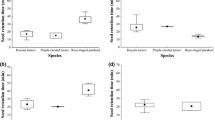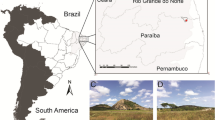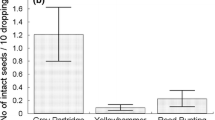Abstract
Seed dispersal by animals is one of the most important plant-animal mutualisms, but saurochory, the dispersal of seeds by reptiles, has received little attention. We investigated the role of the Florida box turtle (Terrapene carolina bauri) as a seed dispersal agent in pine rockland forests of the lower Florida Keys and examined the effect of turtle digestion on seed germination. We obtained seeds of 11 species with fleshy fruits and 2 species with non-fleshy fruits (a grass and legume) from the feces of 145 box turtles collected on Key Deer National Wildlife Refuge from 1999 to 2000. We planted the seeds of nine species and germination percentage (percentage of seeds that germinated during the experiment) varied from 10% to 80%. Comparative germination experiments were conducted with Thrinax morrissii, Serenoa repens, and Byrsonima lucida. We compared the germination percentage and germination rate (number of days from planting to seedling emergence) of seeds from three treatments (seeds recovered from feces, control seeds with pulp, and control seeds without pulp) and continued these experiments for up to 2 years. Passage through the box turtle digestive tract greatly enhanced the germination percentage and germination rate of S. repens, but decreased the germination percentage of B. lucida and T. morrissii, and decreased germination rate for T. morrissii. Subsequent destructive seed viability tests revealed that many ungerminated T. morrissii seeds remained viable, suggesting long-term seed dormancy may occur, even after passage through the turtle digestive system. In addition, the proportion of ungerminated seeds which remained viable was greater for seeds recovered from turtle feces than from control seeds with pulp. Furthermore, removal of fleshy pulp either manually or by the turtle digestive system may allow T. morrissii to escape insect predation.


Similar content being viewed by others
References
Abrahamson WG (1989) Plant-animal interactions. McGraw-Hill, New York
Allaby M (1992) The concise Oxford dictionary of botany. Oxford University Press, Oxford
Baker HG (1989) Some aspects of the natural history of seed banks. In: Leck MA, Parker VT, Simpson RL (eds) Ecology of soil seed banks. Academic, San Diego, Calif., pp 9–21
Barnea A, Yom-Tov Y, Friedman J (1991) Does ingestion by birds affect seed germination? Funct Ecol 5:394–402
Baskin LM, Baskin CC (1989) Physiology of dormancy and germination in relation to seed bank ecology. In: Leck MA, Parker VT, Simpson RL (eds) Ecology of soil seed banks. Academic, San Diego, Calif., pp 54–66
Braun J, Brooks GR Jr (1987) Box turtles (Terrapene carolina) as potential agents for seed dispersal. Am Midl Nat 117:312–318
Bustamante RO, Grez A, Simonetti JA, Vasquez RA, Walkowiak AM (1993) Antagonistic effects of frugivores on seeds of Crypocarya alba (Mol.) Looser (Lauraceae): consequences on seedling recruitment. Acta Oecol 14:739–745
Carlson JE, Menges ES, Marks P (2003) Seed dispersal by Gopherus polyphemus at Archbold Biological Station, Florida. Fla Sci 66:147–154
Castilla AM (1999) Podarcis lilfordi from the Balearic islands as a potential disperser of the rare Mediterranean plant Withania frutescens. Acta Oecol 20:103–107
Castilla AM (2000) Does passage time through the lizard Podarcis lilfordi’s guts affect germination performance in the plant Withania frutescens? Acta Oecol 20:119–124
Clewell AF (1985) Guide to the vascular plants of the Florida panhandle. Florida State University Press, Tallahassee, Fla.
Daubenmire R (1968) Ecology of fire in grasslands. Adv Ecol Res 5:209–266
Dodd CK Jr (2001) North American box turtles: a natural history. University Oklahoma Press, Norman, Okla.
Engel TR (1997) Seed dispersal and plant regeneration by snakes? Ecotropica 3:33–41
Fialho RF (1990) Seed dispersal by a lizard and a tree frog—effect of dispersal site on seed survivorship. Biotropica 22:423–424
Fitch AV (1965) Sensory cues in the feeding of the ornate box turtle. Trans Kans Acad Sci 68:522–532
Hartley LM, Glor RE, Sproston AL, Powell R, Parmerlee JS Jr (2000) Germination rates of seeds consumed by two species of rock iguana (Cyclura spp.) in the Dominican Republic. Caribb J Sci 36:149–151
Howe HF, Smallwood J (1982) Ecology of seed dispersal. Ann Rev Ecol Syst 13:201–228
Iverson JB (1979) Behavior and ecology of the rock iguana Cyclura carinata. Bull Fla State Mus Biol Sci 24:175–358
Izhaki I, Safriel UN (1990) The effect of some Mediterranean scrubland frugivores upon germination patterns. J Ecol 78:56–65
Janzen DH (1984) Dispersal of small seeds by big herbivores: foliage is the fruit. Am Nat 123:338–353
Jordano P (1992) Fruits and frugivory. In: Fenner M (ed) Seeds: the ecology of regeneration in plant communities. Commonwealth Agricultural Bureau International, Wallingford, pp 105–156
Kearns CA, Inouye DW (1993) Techniques for pollination biologists. University Press of Colorado, Niwot, Colo.
Klimstra WD, Newsome F (1960) Some observations on the food coactions of the common box turtle, Terrapene c. carolina. Ecology 41:639–647
Langtimm CA, Dodd CK Jr, Franz R (1996) Estimates of abundance of box turtles (Terrapene carolina bauri) on a Florida island. Herpetologica 52:496–504
Lazell JD Jr (1989) Wildlife in the Florida Keys: a natural history. Island, Washington, D.C.
Martin AC, Zim HS, Nelson AL (1951) American wildlife and plants: a guide to wildlife food habits. Dover, New York
Menges WS (1995) Factors limiting fecundity and germination in small populations of Silene regia (Caryophyllaceae), a rare hummingbird-pollinated prairie forb. Am Midl Nat 133:242–255
Moll D, Jansen KP (1995) Evidence for a role in seed dispersal by two tropical herbivorous turtles. Biotropica 27:121–127
Nelson G (1996) The shrubs and woody vines of Florida: a reference and field guide. Pineapple, Sarasota, Fla.
Nogales M, Delgado JD, Medina FM (1998) Shrikes, lizards and Lycium intricatum (Solanaceae) fruits: a case of indirect seed dispersal on an oceanic island (Alegranza, Canary Islands). J Ecol 86:866–871
Pijl L van der (1982) Principles of dispersal in higher plants. Springer, New York Heidelberg Berlin
Platt SG, Khaing ST, Ko WK, Kalyar (2001) A tortoise survey of Shwe Settaw Wildlife Sanctuary, Myanmar, with notes on the ecology of Geochelone platynota and Indotestudo elongata. Chelon Conserv Biol 4:172–177
Richardson BA, Brunsfeld SJ, Klopfenstein NB (2002) DNA from bird-dispersed seed and wind-disseminated pollen provides insights into postglacial colonization and population genetic structure of whitebark pine (Pinus albicaulis). Mol Ecol 11:215–227
Rust RW, Roth RR (1981) Seed production and seedling establishment in the May-apple, Podophyllum peltatum. Am Midl Nat 105:51–60
Saez E, Traveset A (1995) Fruit and nectar feeding by Podarcis lilfordi (Lacertidae) on Cabrera archipelago (Balearic islands). Herpetol Rev 26:121–123
Schupp EW (1993) Quantity, quality and the effectiveness of seed dispersal by animals. In: Fleming TH, Estrada A (eds) Frugivory and seed dispersal: ecological and evolutionary aspects. Kluwer Academic, Leiden, pp 15–29
Schwartz CW, Schwartz ER (1974) The three-toed box turtle in central Missouri: its population, home range, and movements. Mo Dept Conserv Terr Ser 5:1–28
Scurlock JP (1987) Native trees and shrubs of the Florida Keys. The Florida Keys Land Trust, Key West, Fla.
Silvertown JW, Lovett-Doust J (1993) Introduction to plant population biology. Blackwell Science, Oxford
Snyder JR, Herndon A, Robertson WB (1990) South Florida rockland. In: Myers RL, Ewel JJ (eds) Ecosystems of Florida. University Central Florida Press, Orlando, Fla., pp 230–277
Sokal RR, Rohlf FJ (1981) Biometry. Freeman, San Francisco
Stickel LF (1950) Population and home range relationships of the box turtle, Terrapene carolina (Linnaeus). Ecol Monogr 20:351–378
Strang CA (1983) Spatial and temporal activity patterns in two terrestrial turtles. J Herpetol 17:43–47
Temple SA (1977) Plant-animal mutualism: coevolution with dodo leads to near extinction of plant. Science 197:885–886
Thirakhupt K, van Dijk PP (1994) Species diversity and conservation of turtles in western Thailand. Nat Hist Bull Siam Soc 42:207–259
Tiffney BH (1986) Evolution of seed dispersal syndromes according to the fossil record. In: Murray DR (ed) Seed dispersal. Academic, Sydney, pp 273–305
Tomlinson PB (1980) The biology of trees native to tropical Florida. Harvard University Printing Office, Allston, Mass.
Traveset A (1998) Effect of seed passage through vertebrate frugivores’ guts on germination: a review. Perspect Plant Ecol Evol Systemat 1:151–190
Traveset A, Verdu M (2001) A meta-analysis of the effect of gut treatment on seed germination. In: Levey DJ, Silva WR, Galetti M (eds) Seed dispersal and frugivory: ecology, evolution and conservation. CAB International, Wallingford, pp 339–350
Traveset A, Riera N, Mas RE (2001a) The ecology of seed dispersal of a fruit-color polymorphic species, Myrtus communis, in the Balearic Islands. J Ecol 89:749–760
Traveset A, Riera N, Mas RE (2001b) Passage through bird guts causes interspecific differences in seed germination characteristics. Funct Ecol 15:669–675
Valido A, Nogales M (1994) Frugivory and seed dispersal by the lizard Gallotia galloti (Lacertidae) in a xeric habitat of the Canary Islands. Oikos 70:403–411
Varela RO, Bucher EH (2002) Seed dispersal by Chelonoidis chilensis in the Chaco dry woodland of Argentina. J Herpetol 36:137–140
Vuorisalo T, Watson MA (1990) Fruit dispersal in a clonal perennial, Podophyllum peltatum. Am J Bot Suppl 77:64
Whitaker AM (1987) The role of lizards in New Zealand plant reproductive strategies. N Z J Bot 25:315–328
Zona S (2002) Addition to “A review of animal-mediated seed dispersal of palms”. http://www.virtualherbarium.org/palms/psdispersal
Zona S, Henderson A (1989) A review of animal-mediated seed dispersal of palms. Selbyana 11:6–21
Acknowledgements
The Key Deer National Wildlife Refuge provided logistical support. Joanne Singfield, Jenny McCune, Jana Mott, Christie Whelan, and Sarah Naylor cared for plants, and Qingwen Liu and Xiulan Zhu helped to collect and process fruits. The turtle finding abilities of Trouble were critical to the success of this project. Comments by Augustus McRae, Suzanne Koptur, Eric Menges, Jed Redwine, Woodrow Call, John Geiger, Javier Francisco-Ortega, Doug Levey, and an anonymous reviewer greatly improved an earlier draft of this manuscript. Paulette Johnson and Pedro Quintana-Ascencio are thanked for statistical advice. Suzanne Koptur supplied unpublished fruiting phenology data. Support for H.L. was provided by the Florida Native Plant Society, Tropical Biology Research Awards and Dissertation Year Fellowship from Florida International University, and a grant from the Department of the Interior to M. Ross, J.R. Snyder and S. Koptur (Cooperative Agreement CA-1445-CA09–95–0112). Support for S.G.P. was provided by the Wildlife Conservation Society. This is contribution 62 of the Tropical Biology Program of Florida International University.
Author information
Authors and Affiliations
Corresponding author
Rights and permissions
About this article
Cite this article
Liu, H., Platt, S.G. & Borg, C.K. Seed dispersal by the Florida box turtle (Terrapene carolina bauri) in pine rockland forests of the lower Florida Keys, United States. Oecologia 138, 539–546 (2004). https://doi.org/10.1007/s00442-003-1445-7
Received:
Accepted:
Published:
Issue Date:
DOI: https://doi.org/10.1007/s00442-003-1445-7




